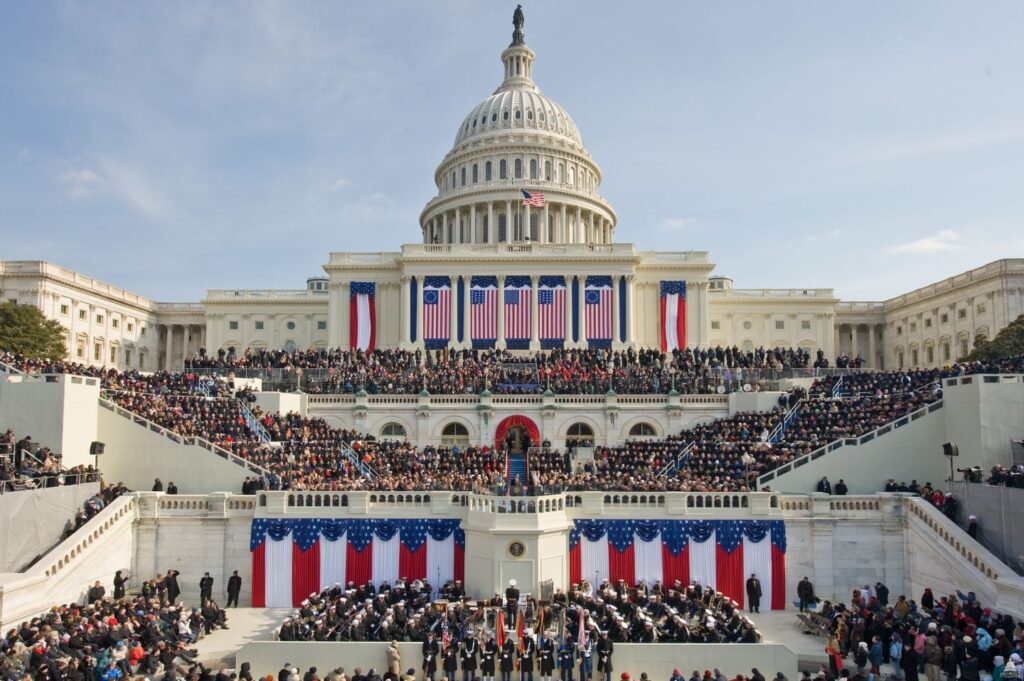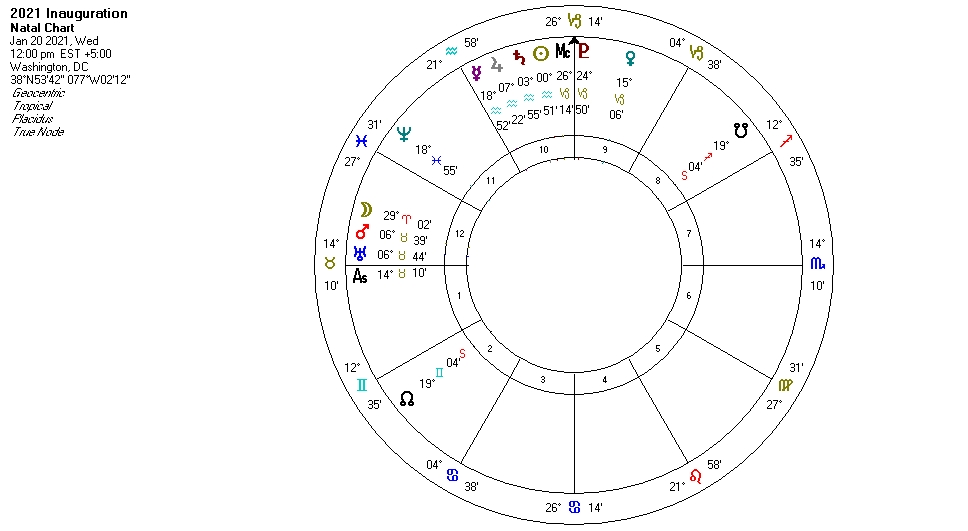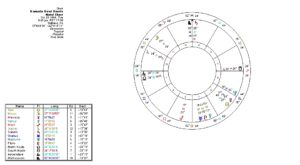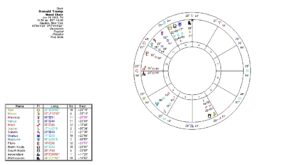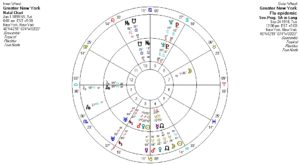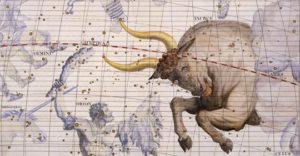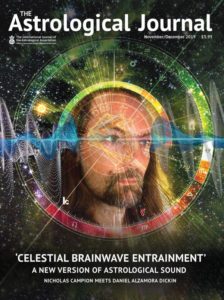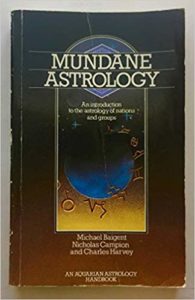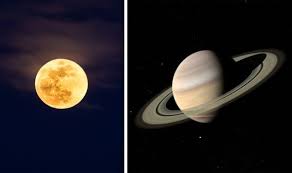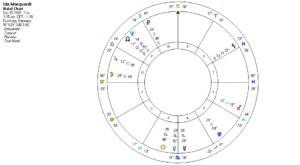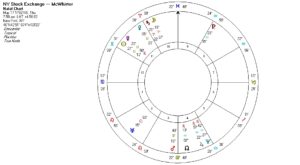In evaluating presidential candidates, I look at several astrological factors. Whether they win or lose is basic, but can be complicated, although there are often clear indicators for success or failure. Does it look like they’ll have a change in responsibility or residence? And what about their continuing relationship with the country?
The natal chart is the most important element. Donald Trump attracts attention with his Sun conjunct Uranus birth eclipse. It brings surprising successes, but, I’ve always felt, will include equally notable falls from grace. Belinda Lai has included a detailed analysis of Trump’s birth chart on AstroPastures and I agree with her analysis that the mutable pattern tends toward one-shot situations, rather than long-term appointments.
Trump has many challenging transits in the coming months. Between October and February, transiting Jupiter, Saturn and Pluto all oppose the president’s Venus. Jupiter and Pluto exactly oppose his Saturn in November and December, close to the election. (They will trine his Midheaven near that time, too, but since Venus rules his MC and Saturn relates to career, I feel the oppositions carry.) Pluto also opposes his natal Venus for the first time on February 18, 2021, drawing him to begin a new life direction.
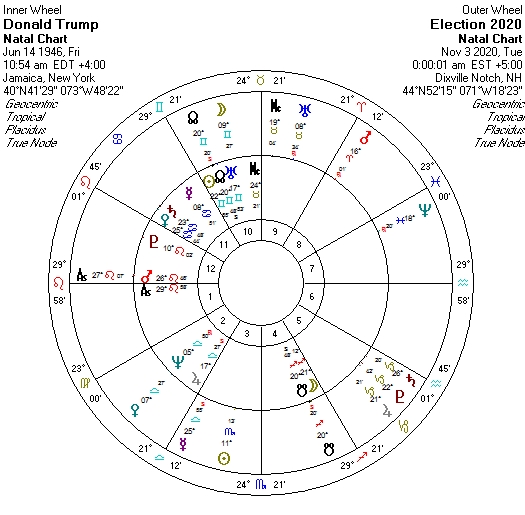
Progressions may be more notable in terms of where a person is going in life. The president’s progressed Mercury in Leo, near his Mars-Pluto midpoint, sextiles natal Uranus in late September, and transiting Uranus sextiles his Mercury in late October. Mercury co-rules his 10th house and is prominent in the 11th so this could point toward unexpected support. But his natal Mercury lacks dignity, and none is added by the sign or 12th house placement of the progression. He can expect help from loyal associates behind the scenes, and there may be a court decision in his favor. But I feel that the challenging aspects outweigh the rest of the picture.
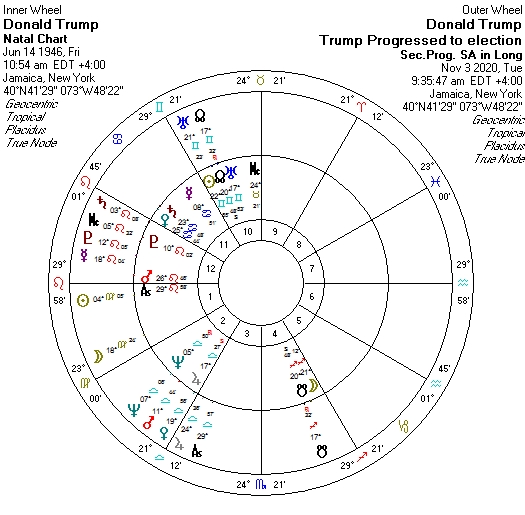
Trump’s progressed Ascendant at 29 Libra 57, denotes the end of a phase in his life. His progressed Venus, Jupiter and Ascendant in Libra will all take exact squares from the heavy Capricorn transits from late October through December. (These may also explain his catching the coronavirus in early October.)
His progressed Midheaven, showing his status and career development, is equally afflicted. The Jupiter-Saturn conjunction in Aquarius will oppose both his progressed Midheaven and progressed Saturn in January of 2021 from the bottom of his progressed chart (traditionally the “end of the matter”).
Trump’s progressed Moon in Virgo squares his natal Uranus in the 10th in October. The transiting Neptune in Pisces station squares natal Uranus in November, while progressed Moon opposes transiting Neptune close to election day, creating a T-square. Transiting Neptune’s continuing aspects from the 7th house aren’t yet exact, but will include squares to his Sun, Moon and Nodes, forming a grand cross and eroding his popularity. The December 14 solar eclipse at 23 Sagittarius also activates the grand cross.
In addition, the progressed Moon is within a degree and a half of conjoining the Midheaven of Joe Biden’s 8:30 a.m. birth chart! It’s as if he’s ready to hand over the reins of government. Or we might say that his work ethic and health situation enhance Biden’s reputation.
The progressed Moon in declination may show periods of time when one achieves great popularity or notoriety. Trump’s Moon progressed Out of Bounds in declination between the ages of 69 and 71, presenting a very unusual period of time when he won the 2016 election. His progressed Moon is now on the downslope and has not been OOB for a few years: he no longer enjoys the responsiveness from the public that he did four years ago.
Trump has some positive progressions, including progressed Moon approaching a trine to progressed U.S. Moon and his progressed Sun near a trine to U.S. progressed Ascendant. However the most notable thing is the number of progressed to progressed aspects that are departing (I count 13 of them under 4 degrees), showing his path moving away from the country’s. The U.S. progressed Moon at 22 Capricorn, South Node at 26 Capricorn and Pluto at 29-1/2 Capricorn are all reinforced by the transits in the same sign that afflict his birth chart.
All of this is within the context of the bigger picture. Donald Trump is experiencing a Nodal return, which often coincides with a life-changing time. See my earlier post on Trump and Kamala Harris’ Nodal returns. And the Inauguration chart, with its prominent Saturn square Uranus, also suggests a change in the party in power. My earlier Inauguration 2021 post shows that this has historically been the case with many new administrations of the past.
I do not believe that Donald Trump will begin a second term as President of the United States. If he’s somehow re-elected, I expect he will face very difficult challenges indeed. I hope to post about Biden’s horoscope soon.

